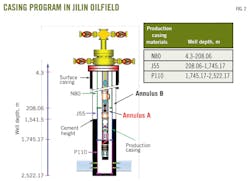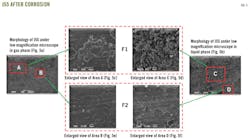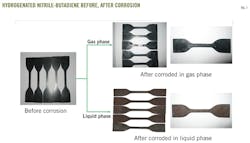Study addresses SCP causes in CO2 injection, production wells
Hongjun Zhu
Yuanhua Lin
Dezhi Zeng
Dapeng Zou Southwest Petroleum University
Chengdu, Sichuan
China
High sustained casing pressure (SCP) threatens worker safety and wellbore integrity. It can be exacerbated in a CO2 environment, such as in CO2-drive injection and production wells, by CO2's corrosive effects.
This article reports on investigations of the causes of SCP in CO2-drive injection and production wells. It discusses tubing and casing leaks, poor cement quality, and packer failures.
Four kinds of effects—piston effect, spiral effect, expansion effect, and temperature effect—can lead to deformation of tubular goods. Which effect may create the greatest impact depends on the specific working condition.
Finally, corrosion of steel, cement, and packer were tested to observe the corrosion characteristics and further verify how the problem can be exacerbated in a CO2 environment.
Casing pressure
When gas is flowing at steady-state in a well, the casing pressure should be bled through a needle valve to match atmospheric pressure. If the casing pressure builds up when the valve is closed, the casing is said to exhibit SCP, which exists inevitably in all gas wells. In some cases, it can become dangerously high. The consequence may be catastrophic if the condition is not brought under control.1
Moreover, it can be exacerbated in a CO2 environment, such as in CO2-drive injection and production wells, due to the acidic property and unavoidable phase transition of CO2.
SCP can have many causes, among which are leaks in pipe strings, cement, and packer. Fig. 1 shows the possible paths.
As in many gas wells, such leaks may form from fatigue fracture of tubulars, deformation failure of packers, or cracking in cement.2-3 But as dissimilar as are the reasons causing leaks in common gas wells, corrosion of supercritical CO2 and change of working conditions make itIn the applications of CO2 flooding, CO2 is often injected as a liquid. When the temperature exceeds 31° C. and the pressure more than 7.3 MPa (about 1,060 psia), CO2 will reach a supercritical state.
At this point, the state of CO2 has a strong ability to dissolve, which can easily cause seals to fail in tubing threads and packers. What's more, the change of working conditions in a water-alternating gas (WAG) process is also a major cause of string deformation. Tubulars, packers, even cements are corroded by CO2 in contact with water, resulting in holes or breaches in pipe strings or packers.
Data analysis
Jilin oilfield in northeast China is in a late period of development. To boost production, operator China National Petroleum Corp. injected CO2 for enhanced oil recovery (EOR). Many old wells, including producing wells and water injection wells, have been converted to CO2 injection wells. Fig. 2 shows the casing program.
Many problems arose during CO2 injection, the most prominent being SCP. Some of old wells have undergone a pressure bleed-down test and a build-up test. The pressure bleed-down test determines whether the pressure can be bled down completely (bleed to 0 MPa). The pressure build-up test followed by pressure bleed-down is to test casinghead pressure that builds back up within 48 hr.
Fig. 3 presents the results of the pressure build-up test and clearly shows that most of wells have existing SCP problems. SCP in some wells is so serious that the casinghead pressure nearly equals surface-tubing pressure.
Table 1 lists the causes for SCP in CO2 injection wells in H59 block.
Tubing, casing leaks
Three conditions can cause leakage in tubing and casing: deformation of tubulars, poor thread sealing, and corrosion.
In production, tubular goods will encounter several working conditions. Four effects arise from the change of temperature and pressure in different working conditions: piston effect (length changes), spiral effect (pressure on the two ends of the tubing that exceeds buckling pressure), expansion effect (differential pressure inside and outside the columns), and temperature effect (temperature changes).
Fig. 4 presents three deformation effects of pipe strings. As shown there, piston effect means that the fluid force acts on the tube step face, where the tubular diameter changes and packer is located, and leads to changes in tubular length. The change of length caused by the piston effect can be calculated as shown in Equation 1 in the accompanying equations box.
The spiral effect is spiral bending deformation of string as a result of the pressure acting on the ends of the tubing exceeding the buckling pressure. Equation 2 calculates the spiral bending elongation of tube.
The expansion effect is caused by the pressure differential between inside and outside the tubing string. Equation 3 calculates the change of length caused by expansion effect.
The temperature effect indicates that the change in tubing length is caused by the temperature change. Equation 4 calculates the length change.
The four effects (Fig. 4) directly result in the deformation of pipe strings, thus further affecting the pipe string's strength and packer's sealing. What kind of effect may create the greatest impact depends on the specific working condition. If the four kinds of effects occur simultaneously, the total change in string length is the sum of changing lengths induced by the four effects.
Erosion on tubing joints is a main factor leading to poor thread sealing. When high speed fluid flows through the "J" region, which exists in the middle of API thread, the change of flow field will cause local eddy and pressure fluctuations, weakening the thread strength.
In addition, under the condition of installation defects, a gap may open between the two sides of thread engagement surface, providing channels for gas migration.
The corrosive effects of CO2 are well known. We have chosen three grades of metal materials (P110, N80, and J55) used in CO2 injection wells to observe the corrosion of steel by supercritical CO2.
In the tests, each grade of materials was machined on four specimens of the same size 30×20×3 mm. First, specimens were separately put into the gas phase and liquid phase in an autoclave with NaCl solution (Cl- concentration of 6,217 mg/l.). Then nitrogen was pumped into the autoclave for 2 hr to drive out oxygen. After that, CO2 was pumped in until the autoclave was full. Then the environment was heated to 90° C. and pressured to 35 MPa. The specimens were kept in this environment for 7 days.
Table 2 shows the results of the experiment on these three materials.
It can be seen that the corrosion rate in gas phase is much lower than the rate in liquid phase. P110 presents the best corrosion resistance, followed by N80. Moreover, a scanning electron microscope was used to observe the corrosion products more closely.
Take J55, for example: Fig. 5 shows the micromorphology of J55 after corrosion in gas and liquid phase. The comparison chart shows that corrosion products accumulate less in gas phase than in liquid phase. What's more, its corrosion product film is smoother and more dense, which can reduce the corrosion rate. There are lots of FeCO3 crystal particles on the surface of specimens. After corroding in liquid phase, however, its corrosion product film is so loose that it can't prevent corrosion.
Poor cement quality
Gas migration during cementing is another cause of SCP. During hydration, cement goes through a physical state in which it does not behave as fluid or solid. In this transition state, the cement plug has no capacity to transmit the entire hydrostatic pressure. Therefore, gas can invade the cement in this process.
If the mud is not replaced completely during the cementing operation, perforating paths will form in the production layers. In addition, chemical dehydration and filtrate loss can also cause volume shrinkage, forming leak paths. Improper mud component is a main reason for chemical dehydration and filtrate loss. The improper mud mainly performs as high filtrate-loss rate, poor mud stability, large shrinkage of volume, and so on. If fluid and filtrate losses are not brought under control, they will result in dehydration in the annulus. Severe dehydration may lead to reduction of pressure in cement. Once the pressure falls lower than the formation pressure, gas will flow upward.
The cement sheath is easily damaged from pressure or temperature changes caused by production operations, such as CO2 injection, gas lift, pressure testing, hydraulic stimulation, and so on. These operations cause expansion of the cement sheath, resulting in the separation of the casing and cement.
Also, corrosion of cement was tested. Cylindrical cement blocks of 25.4 mm × 25.4 mm were used for the corrosion test. The experimental method was the same as stated previously. Fig. 6 shows the internal structure before and after corrosion in gas and liquid phase. The original dense structure has been destroyed after corrosion.
After corrosion in gas phase, the original flake structure turned to crystal and fine granules. The energy spectrum analysis indicates that the corrosion product consists of carbon, oxygen, and calcium.
The molecular formula of the corrosion product may be CaCO3, but after corrosion in liquid CO2, it turns to schistose structure, and the elements carbon, oxygen, calcium, and silicon form the corrosion product. So the molecular formula may be CaCO3 and SiO2.
Packer failure
The packer must bear a certain pressure differential. The original design is suitable only in the early stages or in a well with good permeability, while with the increase in the pressure differential between layers or in a high-pressure low-permeability reservoir, the pressure differential may change sharply. In addition, liquid hammer may take place in low water cut, highly viscous crude oil wells. The two phenomena can cause the packer to fail.
Corrosion is also another reason for packer failure. Hydrogenated nitrile-butadiene rubber is the core component of the packer. A set of tests evaluated the corrosion characteristics of rubber in gas phase and liquid phase. Dumbbell-shaped hydrogenated nitrile-butadiene specimens and a rubber canister of packer were adopted as test materials.
Fig. 7 shows the dumbbell-shaped hydrogenated nitrile-butadiene specimens. We can see that bubbles are generated on the surface of specimens after corrosion both in liquid and gas phase. The contrast data listed in Table 3 indicate tensile strength decreases in bot gas and liquid phases. But the change of performance in liquid phase trends more severe than that in gas phase.
Fig. 8 shows a rubber canister. The original packer's rubber canister is laid in the middle, while rubber canisters after corrosion in gas and liquid phase are laid in the left and right, respectively. It is clear that the packer's rubber has been damaged and has fragmented in both gas and liquid phases.
Acknowledgement
Research was cofinanced by Key Project of Sichuan Provincial Education Department (No: 12ZA189) and China National Natural Science Foundation (No: 51074135). The authors wish to thank Taihe Shi, Zhi Zhang, and Yuanguang Yang for help in improving this article, Jilin Oilfiled for its support of this research, and Feng Wang and Deping Zhang for providing data.
References
1. Milanovic, D., and Smith, L., "A Case History of Sustainable Annulus Pressure in Sour Wells- Prevention, Evaluation and Remediation," SPE High Pressure/High Temperature Sour Well Design Applied Technology Workshop, The Woodlands, Tex., May 17-19, 2005.
2. Nicolas, J.H., Dean, A.C., and Steven, L.B., "Utilizing Sustained Casing Pressure Analog to Provide Parameters to Study CO2 Leakage Rates along a Wellbore," SPE International Conference on CO2 Capture, Storage, and Utilization, San Diego, Nov. 2-4, 2009.
3. Xu, R., and Wojtanowicz, A.K., "Diagnosis of Sustained Casing Pressure from Bleed-off/Buildup Testing Patterns," SPE Production and Operations Symposium, Oklahoma City, Mar. 24-27, 2001.
The Authors
Hongjun Zhu ([email protected]) is an associate professor in the petroleum engineering department of Southwest Petroleum University (SWPU), Chengdu City, Sichuan Province, China. He holds BS and MS degrees in fluid mechanics from Hohai University.
Yuanhua Lin ([email protected]) is a professor in the petroleum engineering department at Southwest Petroleum University working in pipe string mechanics. He holds BS and MS degrees in mechanical engineering and a PhD in drilling engineering from Southwest Petroleum University.
Dezhi Zeng ([email protected]) is a professor in the petroleum engineering department at Southwest Petroleum University researching and teaching oil well construction engineering. He holds BS and MS degrees in mechanical engineering and a PhD in drilling engineering from Southwest Petroleum University.
Dapeng Zou ([email protected]) is a postgraduate in the petroleum engineering department at Southwest Petroleum University, involved in researching pressure control and pipe string mechanics in drilling engineering. He holds a BS in petroleum engineering from Southwest Petroleum University.















